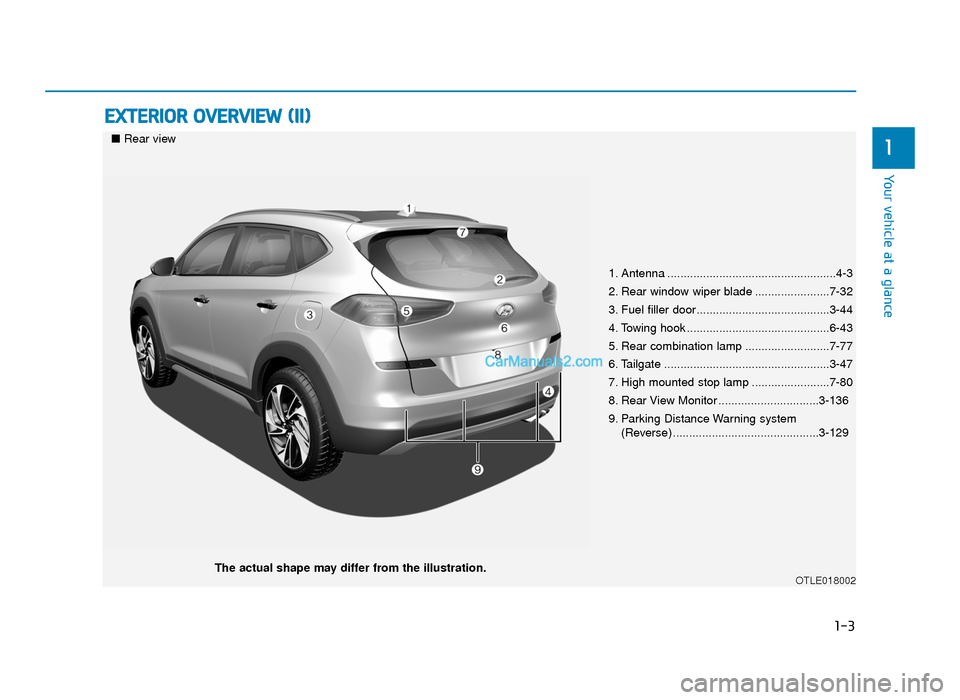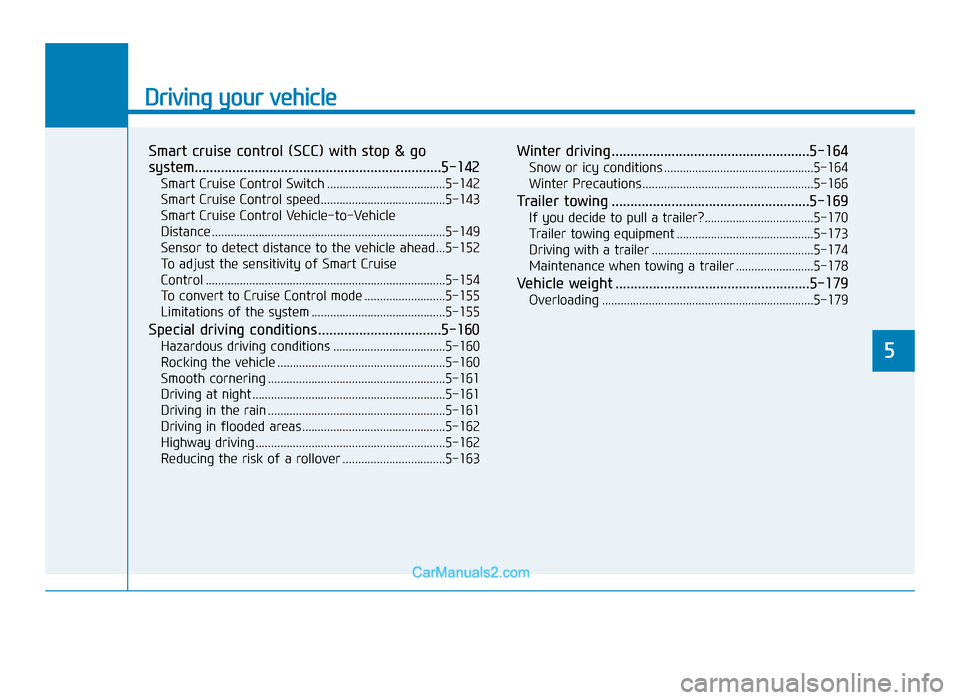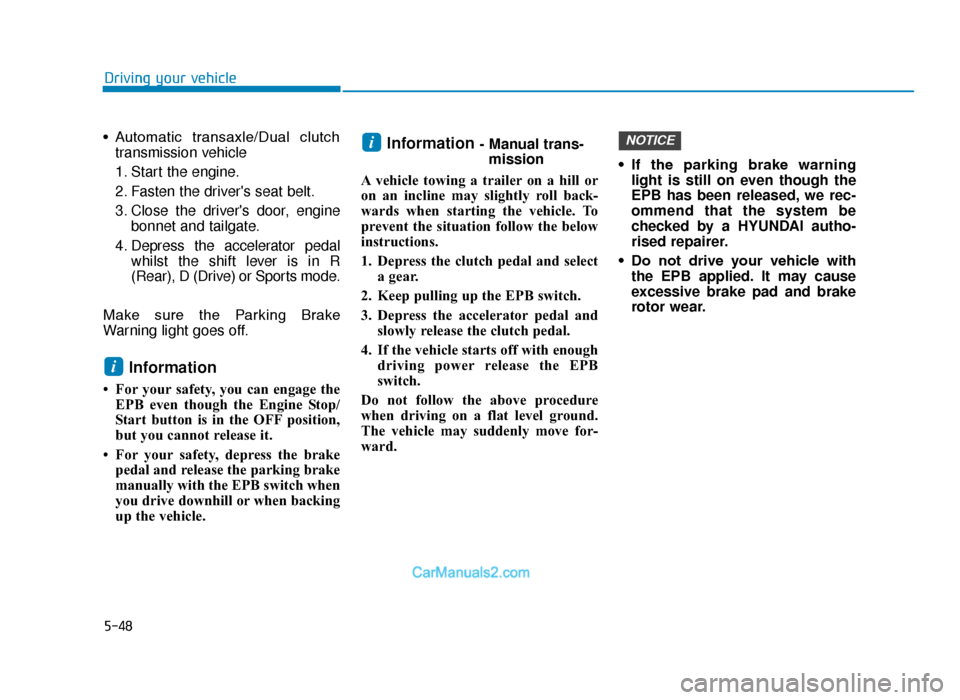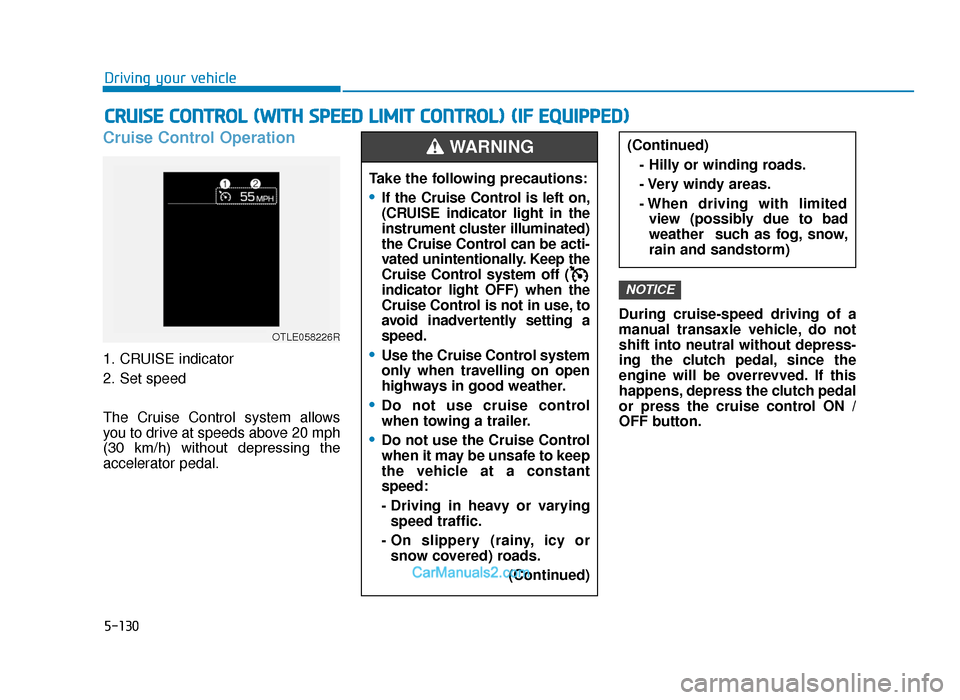2019 Hyundai Tucson towing
[x] Cancel search: towingPage 15 of 685

1-3
Your vehicle at a glance
EXTERIOR OVERVIEW (II)
1
1. Antenna ....................................................4-3
2. Rear window wiper blade .......................7-32
3. Fuel filler door.........................................3-44
4. Towing hook ............................................6-43
5. Rear combination lamp ..........................7-77
6. Tailgate ...................................................3-47
7. High mounted stop lamp ........................7-80
8. Rear View Monitor ...............................3-136
9. Parking Distance Warning system (Reverse) .............................................3-129
OTLE018002
■Rear view
The actual shape may differ from the illustration.
TLe UK 1.qxp 5/10/2018 11:27 AM Page 3
Page 327 of 685

Driving your vehicle
Smart cruise control (SCC) with stop & go
system..................................................................\
5-142
Smart Cruise Control Switch ......................................5-142
Smart Cruise Control speed........................................5-143
Smart Cruise Control Vehicle-to-Vehicle
Distance ........................................................................\
...5-149
Sensor to detect distance to the vehicle ahead ...5-152
To adjust the sensitivity of Smart Cruise
Control ........................................................................\
.....5-154
To convert to Cruise Control mode ..........................5-155
Limitations of the system ...........................................5-155
Special driving conditions .................................5-160
Hazardous driving conditions ....................................5-160
Rocking the vehicle ......................................................5-160
Smooth cornering .........................................................5-161
Driving at night ..............................................................5-161
Driving in the rain .........................................................5-161
Driving in flooded areas..............................................5-162
Highway driving .............................................................5-162
Reducing the risk of a rollover .................................5-163
Winter driving .....................................................5-164
Snow or icy conditions ................................................5-164
Winter Precautions .......................................................5-166
Trailer towing .....................................................5-169
If you decide to pull a trailer?...................................5-170
Trailer towing equipment ............................................5-173
Driving with a trailer ....................................................5-174
Maintenance when towing a trailer .........................5-178
Vehicle weight ....................................................5-179
Overloading ....................................................................5-17\
9
5
TLe UK 5.qxp 5/10/2018 12:18 PM Page 3
Page 372 of 685

5-48
Driving your vehicle
• Automatic transaxle/Dual clutch transmission vehicle
1. Start the engine.
2. Fasten the driver's seat belt.
3. Close the driver's door, engine bonnet and tailgate.
4. Depress the accelerator pedal whilst the shift lever is in R
(Rear), D (Drive) or Sports mode.
Make sure the Parking Brake
Warning light goes off.
Information
• For your safety, you can engage the EPB even though the Engine Stop/
Start button is in the OFF position,
but you cannot release it.
• For your safety, depress the brake pedal and release the parking brake
manually with the EPB switch when
you drive downhill or when backing
up the vehicle.
Information - Manual trans-mission
A vehicle towing a trailer on a hill or
on an incline may slightly roll back-
wards when starting the vehicle. To
prevent the situation follow the below
instructions.
1. Depress the clutch pedal and select a gear.
2. Keep pulling up the EPB switch.
3. Depress the accelerator pedal and slowly release the clutch pedal.
4. If the vehicle starts off with enough driving power release the EPB
switch.
Do not follow the above procedure
when driving on a flat level ground.
The vehicle may suddenly move for-
ward. • If the parking brake warning
light is still on even though the
EPB has been released, we rec-
ommend that the system be
checked by a HYUNDAI autho-
rised repairer.
• Do not drive your vehicle with the EPB applied. It may cause
excessive brake pad and brake
rotor wear.NOTICEi
i
TLe UK 5.qxp 5/10/2018 12:21 PM Page 48
Page 397 of 685

5-73
Driving your vehicle
5
• Always hold the steering wheelfirmly when you are driving off-
road.
Emergency precautions
Tyres
Do not use tyre and wheel with dif-
ferent size and type from the one
originally installed on your vehicle. It
can affect the safety and perform-
ance of your vehicle, which could
lead to steering failure or rollover
causing serious injury.
When replacing the tyres, be sure to
equip all four tyres with the tyre and
wheel of the same size, type, tread,
brand and load-carrying capacity. If
you equip your vehicle with any
tyre/wheel combination not recom-
mended by HYUNDAI for off-road
driving, you should not use these
tyres for highway driving.
Towing
4WD vehicles must be towed with a
wheel lift and dollies or flatbed equip-
ment with all the wheels off the
ground. For more details, refer to
"Towing" in chapter 6.
Dynamometer testing
A full-time 4WD vehicle must be test-
ed on a special four wheel chassis
dynamometer.
OTLE055003
Do not grab the inside of the
steering wheel when you are
driving off-road. You may hurt
your arm by a sudden steering
bonnet or from steering wheel
rebound due to an impact with
objects on the ground. You
could lose control of the steer-
ing wheel which may lead to
serious injury or death.
WARNING
Never start or run the engine
whilst a full-time 4WD vehicle is
raised on a jack. The vehicle can
slip or roll off of a jack causing
serious injury or death to you or
those nearby.
WARNING
TLe UK 5.qxp 5/10/2018 12:23 PM Page 73
Page 422 of 685

5-98
Driving your vehicle
Detecting pedestrians
The sensor may be limited when:
• The pedestrian is not fully detectedby the camera recognition system,
for example, if the pedestrian is
leaning over or is not fully walking
upright
• The pedestrian is moving very quickly or appears abruptly in the
camera detection area
• The pedestrian is wearing clothing that easily blends into the back-
ground, making it difficult to be
detected by the camera recogni-
tion system
• The outside lighting is too bright (e.g. when driving in bright sunlight
or in sun glare) or too dark (e.g.
when driving on a dark rural road
at night)
• It is difficult to detect and distin- guish the pedestrian from other
objects in the surroundings, for
example, when there is a group of
pedestrians, cyclists or a large
crowd • There is an item similar to a per-
son's body structure
• The pedestrian is small
• The pedestrian has impaired mobility
• The sensor recognition is limited
• The radar sensor or camera is blocked with a foreign object or
debris
• Inclement weather such as heavy rain or snow obscures the field of
view of the radar sensor or camera
• When light coming from a street light or an oncoming vehicle is
reflected on a wet road surface
such as a puddle in the road
• The field of view in front is obstructed by sun glare
• The windscreen glass is fogged up; a clear view of the road is
obstructed
• The adverse road conditions cause excessive vehicle vibrations whilst
driving
• When the pedestrian suddenly interrupts in front of the vehicle
•Do not use the Forward
Collision avoidance Assist
(FCA) system when towing a
vehicle. Application of the
FCA system whilst towing
may adversely affect the safe-
ty of your vehicle or the tow-
ing vehicle.
•Use extreme caution when the
vehicle in front of you has
cargo that extends rearward
from the cab, or when the
vehicle in front of you has
higher ground clearance.
•The FCA system is designed
to detect and monitor the
vehicle ahead or detect a
pedestrian in the roadway
through radar signals and
camera recognition. It is not
designed to detect bicycles,
motorcycles, or smaller
wheeled objects such as lug-
gage bags, shopping carts, or
strollers.
(Continued)
WARNING
TLe UK 5.qxp 5/10/2018 12:25 PM Page 98
Page 454 of 685

5-130
Driving your vehicle
Cruise Control Operation
1. CRUISE indicator
2. Set speed
The Cruise Control system allows
you to drive at speeds above 20 mph
(30 km/h) without depressing the
accelerator pedal.During cruise-speed driving of a
manual transaxle vehicle, do not
shift into neutral without depress-
ing the clutch pedal, since the
engine will be overrevved. If this
happens, depress the clutch pedal
or press the cruise control ON /
OFF button.
NOTICE
CRUISE CONTROL (WITH SPEED LIMIT CONTROL) (IF EQUIPPED)
OTLE058226R
Take the following precautions:
•If the Cruise Control is left on,
(CRUISE indicator light in the
instrument cluster illuminated)
the Cruise Control can be acti-
vated unintentionally. Keep the
Cruise Control system off (
indicator light OFF) when the
Cruise Control is not in use, to
avoid inadvertently setting a
speed.
•Use the Cruise Control system
only when travelling on open
highways in good weather.
•Do not use cruise control
when towing a trailer.
•Do not use the Cruise Control
when it may be unsafe to keep
the vehicle at a constant
speed:
- Driving in heavy or varying
speed traffic.
- On slippery (rainy, icy or snow covered) roads.
(Continued)
(Continued)- Hilly or winding roads.
- Very windy areas.
- When driving with limitedview (possibly due to bad
weather such as fog, snow,
rain and sandstorm)WARNING
TLe UK 5.qxp 5/10/2018 12:28 PM Page 130
Page 459 of 685

5-135
Driving your vehicle
5
Cruise Control operation
1. CRUISE indicator
2. Set speed
The Cruise Control system allows you
to drive at speeds above 20 mph
(30 km/h) without depressing the
accelerator pedal.During cruise-speed driving of a
manual transaxle vehicle, do not
shift into neutral without depress-
ing the clutch pedal, since the
engine will be overrevved. If this
happens, depress the clutch pedal
or press the cruise control ON /
OFF button.
NOTICE
CRUISE CONTROL (IF EQUIPPED)
Take the following precautions:
•If the Cruise Control is left on,
(CRUISE indicator light in the
instrument cluster is illumi-
nated) the Cruise Control can
be activated unintentionally.
Keep the Cruise Control sys-
tem off (CRUISE indicator
light OFF) when the Cruise
Control is not in use, to avoid
inadvertently setting a speed.
•Use the Cruise Control system
only when travelling on open
highways in good weather.
•Do not use cruise control
when towing a trailer.
(Continued)
(Continued)
•Do not use the Cruise Control
when it may be unsafe to keep
the vehicle at a constant
speed:
- Driving in heavy or varyingspeed traffic.
- On slippery (rainy, icy or snow covered) roads.
- Hilly or winding roads.
- Very windy areas.
- When driving with limited view (possibly due to bad
weather such as fog, snow,
rain and sandstorm)
WARNING
OTM058156E
TLe UK 5.qxp 5/10/2018 12:29 PM Page 135
Page 485 of 685

5-161
Driving your vehicle
5
Information
The ESC system (if equipped) must be
turned OFF before rocking the vehi-
cle.
If you are still stuck after rocking
the vehicle a few times, have the
vehicle pulled out by a tow vehicle
to avoid engine overheating, pos-
sible damage to the transaxle, and
tyre damage. See "Towing" in
chapter 6.
Smooth cornering
Avoid braking or gear changing in
corners, especially when roads are
wet. Ideally, corners should always
be taken under gentle acceleration.
Driving at night
Night driving presents more hazards
than driving in the daylight. Here are
some important tips to remember:
• Slow down and keep more dis-tance between you and other vehi-
cles, as it may be more difficult to
see at night, especially in areas
where there may not be any street
lights.
• Adjust your mirrors to reduce the glare from other driver's head-
lamps.
• Keep your headlamps clean and properly aimed. Dirty or improperly
aimed headlamps will make it
much more difficult to see at night.
• Avoid staring directly at the head- lamps of oncoming vehicles. You
could be temporarily blinded, and it
will take several seconds for your
eyes to readjust to the darkness.
Driving in the rain
Rain and wet roads can make driving
dangerous. Here are a few things to
consider when driving in the rain or on
slick pavement:
• Slow down and allow extra followingdistance. A heavy rainfall makes it
harder to see and increases the dis-
tance needed to stop your vehicle.
• Turn OFF your Cruise Control. (if equipped)
• Replace your windscreen wiper blades when they show signs of
streaking or missing areas on the
windscreen.
• Be sure your tyres have enough tread. If your tyres do not have
enough tread, making a quick stop
on wet pavement can cause a skid
and possibly lead to an accident.
See "Tyre Replacement" in chap-
ter 7.
• Turn on your headlamps to make it easier for others to see you.
• Driving too fast through large pud- dles can affect your brakes. If you
must go through puddles, try to
drive through them slowly.
NOTICE
i
TLe UK 5.qxp 5/10/2018 12:32 PM Page 161